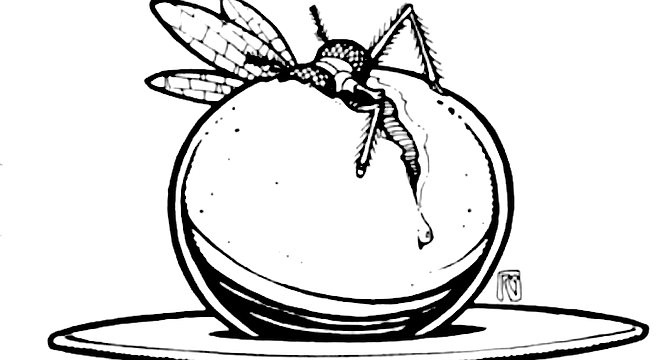 Facebook
Facebook
 X
X
 Instagram
Instagram
 TikTok
TikTok
 Youtube
Youtube

Dear Matt: Where do fruit flies come from? / bring borne some fresh fruit, and in no time, fruit flies are (seemingly) enjoying the fruit. They don't eat much, but I'm curious. — Gene, La Jolla
Time flies like an arrow, fruit flies like an apple. The quote comes from some puckish entomologist, apparently. The flies come from — well, everywhere. Where there’s fruit, there’s flies. Worldwide. Two thousand species. Lurking in loquats, peeking out of peaches, bunkered in bunches of grapes. Sometimes you bring them home with you from the store and sometimes they squeeze through the screens when your windows are open. They’re so ubiquitous they’ve been called animal weeds. That paradise of rotting fruit, Hawaii, supports 1000 species of the family Drosophilidae.
What fruit flies like to eat most of all are the yeasts found on fruits that cause fruit to decay. But they’ll just as happily consume fruit-associated bacteria, fungus, slimes, and even the byproduct of decaying fruit, alcohol. One of the flies’ favorite places to hang out is in wineries, where they might be lolling around in fruit waste or vats in an environment that’s as much as 20 percent alcohol. They can get away with it because at all stages of life, from eggs to larvae to adults, fruit flies produce a substance called alcohol dehydrogenase that breaks down the toxic ethanol in fermenting fruit into nonlethal aldehydes and ketones. For some reason that escapes me, scientists in laboratories have even proved that fruit flies can survive on alcohol fumes when no fruit is present.
While they may be a bane to you, one high-profile member of the fruit fly family is leading the way into the 21st-century world of gene tinkering and chromosome swapping. Drosophila melanogaster is the lab animal most favored by genetics researchers. Though I’ve yet to see animal rights folks picketing to save the fruit flies, millions of them are sacrificed each year in the name of science. They’ve got big, easy-to-see genetic material, produce a new generation every two weeks, and can live on leftovers from the scientists’ lunch. What more could you ask for? Another place that fruit flies are a boon is at the zoo. Fruit destined for the hummingbird enclosure is deliberately left to sit around to attract flies, then fruit and flies are put in the cage with the birds, which eat the Drosophilidae as a good source of protein. So you see, the fruit fly is your friend.
And if you really want to be in the know, fruit-flywise, call them vinegar flies or pomace flies. That’s how entomologists know them. When bugmeisters talk about “fruit flies,” they’re referring to members of the family Tephritidae, which includes such nifty-sounding critters as apple maggot flies.


Dear Matt: Where do fruit flies come from? / bring borne some fresh fruit, and in no time, fruit flies are (seemingly) enjoying the fruit. They don't eat much, but I'm curious. — Gene, La Jolla
Time flies like an arrow, fruit flies like an apple. The quote comes from some puckish entomologist, apparently. The flies come from — well, everywhere. Where there’s fruit, there’s flies. Worldwide. Two thousand species. Lurking in loquats, peeking out of peaches, bunkered in bunches of grapes. Sometimes you bring them home with you from the store and sometimes they squeeze through the screens when your windows are open. They’re so ubiquitous they’ve been called animal weeds. That paradise of rotting fruit, Hawaii, supports 1000 species of the family Drosophilidae.
What fruit flies like to eat most of all are the yeasts found on fruits that cause fruit to decay. But they’ll just as happily consume fruit-associated bacteria, fungus, slimes, and even the byproduct of decaying fruit, alcohol. One of the flies’ favorite places to hang out is in wineries, where they might be lolling around in fruit waste or vats in an environment that’s as much as 20 percent alcohol. They can get away with it because at all stages of life, from eggs to larvae to adults, fruit flies produce a substance called alcohol dehydrogenase that breaks down the toxic ethanol in fermenting fruit into nonlethal aldehydes and ketones. For some reason that escapes me, scientists in laboratories have even proved that fruit flies can survive on alcohol fumes when no fruit is present.
While they may be a bane to you, one high-profile member of the fruit fly family is leading the way into the 21st-century world of gene tinkering and chromosome swapping. Drosophila melanogaster is the lab animal most favored by genetics researchers. Though I’ve yet to see animal rights folks picketing to save the fruit flies, millions of them are sacrificed each year in the name of science. They’ve got big, easy-to-see genetic material, produce a new generation every two weeks, and can live on leftovers from the scientists’ lunch. What more could you ask for? Another place that fruit flies are a boon is at the zoo. Fruit destined for the hummingbird enclosure is deliberately left to sit around to attract flies, then fruit and flies are put in the cage with the birds, which eat the Drosophilidae as a good source of protein. So you see, the fruit fly is your friend.
And if you really want to be in the know, fruit-flywise, call them vinegar flies or pomace flies. That’s how entomologists know them. When bugmeisters talk about “fruit flies,” they’re referring to members of the family Tephritidae, which includes such nifty-sounding critters as apple maggot flies.
Comments